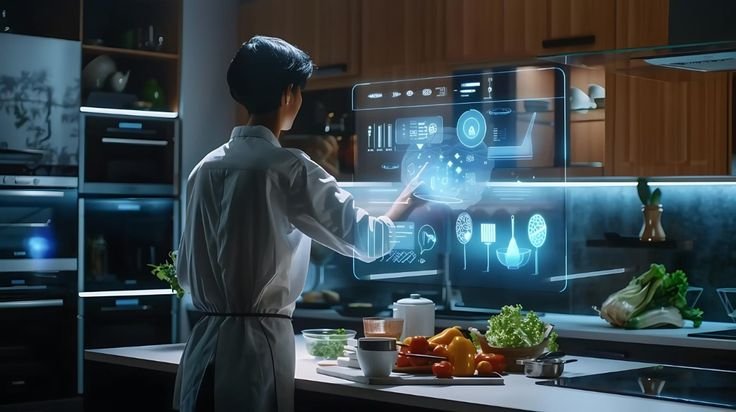The first time I ordered food through an app, it felt like magic. I tapped a screen, and 30 minutes later, a guy with a motorbike handed me hot biryani. No phone calls, no bargaining, no “address samajh nahi aya” drama. Just food, tech, and hunger solved.
That, in a nutshell, is FoodTech. It’s the marriage of food and technology, and startups are the chefs cooking up this revolution. From delivery apps to lab-grown meat, cloud kitchens to smart fridges — FoodTech startups are rethinking how food is grown, made, delivered, and consumed.
What Are FoodTech Startups?
In plain language: these are young companies that use technology to fix problems in the food chain.
Some focus on the front end (like delivery apps — Uber Eats, Foodpanda, DoorDash). Others target the back end (agri-data platforms, robotic kitchens, supply chain software). And some are downright futuristic — like companies growing burgers without cows or milk without cows.
Think of them as the “techies in aprons,” coding solutions to hunger, waste, and convenience.
How FoodTech Sneaks Into Daily Life
You’re craving pizza at midnight? Delivery app, 3 clicks, done.
Grocery shopping? Apps like Instacart, BigBasket, or Airlift (RIP but legendary in Pakistan) bring vegetables to your door.
Watching your health? Wearables sync with diet apps that suggest meals.
Restaurants struggling? They launch “cloud kitchens” that exist only online.
Eco-conscious eater? You order plant-based meat that tastes suspiciously close to chicken nuggets.
FoodTech doesn’t just feed bellies — it feeds habits, lifestyles, and sometimes even identities (“I’m vegan, but high-tech vegan”).
Why People Love It
Convenience – Order, pay, track in real time.
Variety – Menus from ten countries, available from your couch.
Transparency – Nutrition labels, reviews, and ingredient info upfront.
Speed – Meals at your door in under 30 minutes.
Innovation – From drone deliveries to AI-recommended diets.
I once ordered groceries while half-asleep in bed. By morning, fresh tomatoes were waiting outside my door. Lazy? Yes. Magical? Absolutely.
The Fun Side of FoodTech
FoodTech startups get really creative:
Cloud Kitchens – Restaurants without dining halls, only delivery-based kitchens.
AI Nutritionists – Apps suggesting meal plans based on your body data.
Food Waste Solutions – Platforms redirect extra food from restaurants to NGOs.
Lab-Grown Meat – Real meat, but grown in labs instead of farms.
Robotic Chefs – Machines flipping burgers and frying fries better than humans (and never complaining).
I once saw a video of a robot arm making pizza. Honestly, it looked clumsy at first, but the end result? Perfectly round, evenly baked, Instagram-worthy.
The Not-So-Tasty Side
Of course, it’s not all delicious.
High Costs – Lab-grown meat is still pricey.
Logistics Nightmares – Traffic, weather, or a missing delivery rider = cold food.
Health Concerns – Ultra-processed fake meats raise nutrition questions.
Dependence on Apps – What happens when servers crash? Hunger crisis.
Sustainability Issues – Delivery packaging = mountains of plastic waste.
True story: once my app showed “Your order is on the way.” I waited 1 hour. Then another. Finally, rider called: “Sir, restaurant band hai.” FoodTech is smart, but not that smart yet.
FoodTech Around the World
The US, startups like DoorDash, Impossible Foods, and Beyond Meat lead the way.
Europe, there’s heavy focus on sustainability and reducing food waste.
Asia, delivery apps dominate (Swiggy, Zomato, Foodpanda, GrabFood).
Pakistan, startups like Cheetay, Krave Mart, and Foodpanda experiments bring groceries and meals to doorsteps.
Africa, FoodTech solves basic food access via SMS-based ordering systems.
Different places, same hunger — but technology tailors itself to local needs.
The Future – A Bit Sci-Fi
Here’s where things might go:
3D-Printed Food – Imagine printing your pizza or chocolate bar at home.
Drone Deliveries – Food arriving by flying robot instead of rider.
Personalized DNA Diets – Apps recommending meals based on your genetic code.
Zero-Waste Kitchens – Algorithms predicting demand so no food goes to waste.
Synthetic Proteins – Meat, milk, eggs — all made without animals.
Picture this: your smartwatch detects low energy, syncs with a kitchen robot, and a perfectly balanced smoothie appears in 2 minutes. Black Mirror vibes? Maybe. But possible.
The Ethical Questions
With every tasty innovation, there’s fine print:
Will traditional restaurants survive? Cloud kitchens threaten old models.
Job losses – Robots may replace cooks and delivery riders.
Health impact – Are lab foods safe long-term?
Cultural food identity – Will “tech meals” erase traditional cooking?
Equity – Do only the rich get access to healthy, high-tech food?
Food isn’t just fuel; it’s culture, family, tradition. Tech startups sometimes forget that chapati rolled by your grandmother carries more than calories — it carries love.
My Two Cents
I love FoodTech, but cautiously. Ordering groceries online has saved me countless trips. But I also worry we’re losing the warmth of food as a shared human experience. Apps can deliver meals, but they can’t deliver the joy of cooking together, or the smell of naan fresh off the tandoor.
Still, when I’m too tired to cook, nothing beats a quick tap on Foodpanda. So yes, I’m guilty of enjoying the convenience — while secretly hoping robots never fully replace human chefs.
Quick Q&A
Are FoodTech startups just delivery apps?
Nope. They cover farming, production, packaging, nutrition, everything.
Is lab-grown meat real?
Yes, it’s biologically meat. Just made in labs instead of farms.
Do FoodTech startups solve hunger?
They help, but hunger is more about economics and access than apps.
Are they sustainable?
Some are, some aren’t. Packaging waste is still a big problem.
Will robots replace chefs?
Maybe for fast food. But fine dining? Probably not — humans still add artistry.
